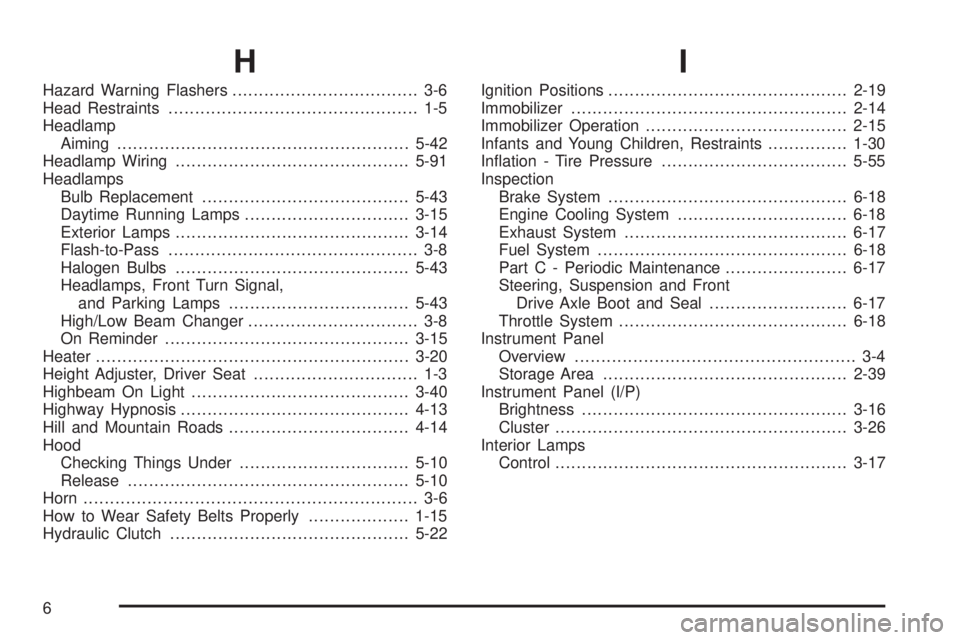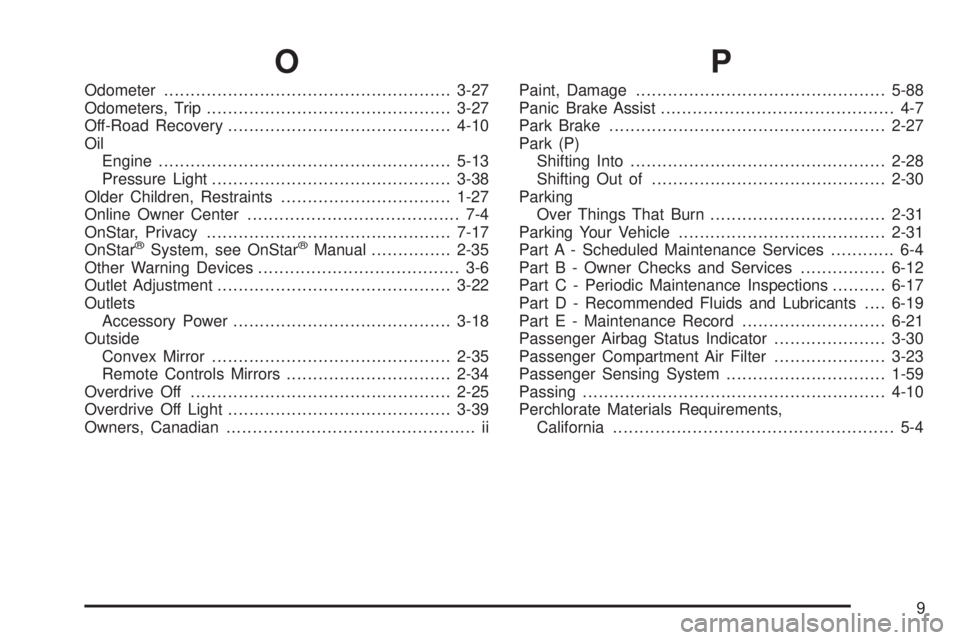check engine light PONTIAC VIBE 2008 User Guide
[x] Cancel search | Manufacturer: PONTIAC, Model Year: 2008, Model line: VIBE, Model: PONTIAC VIBE 2008Pages: 368, PDF Size: 5.7 MB
Page 237 of 368

When to Check and What to Use
The reservoir is located
at the back of the engine
compartment, on the
driver’s side of the vehicle.
SeeEngine Compartment
Overview on page 5-12
for more information
on location.
Refer to the Maintenance Schedule to determine
how often you should check the �uid level in your
master cylinder reservoir and for the proper �uid.
SeePart B: Owner Checks and Services on page 6-12
andPart D: Recommended Fluids and Lubricants
on page 6-19.
How to Check and Add Fluid
Check to make sure that the �uid level is at or above
the MIN mark. If the level is below the MIN mark,
see the instructions on the reservoir cap.
Engine Coolant
Your vehicle was factory-�lled with a coolant developed
to last for �ve years or 150,000 miles (240 000 km),
whichever occurs �rst. When coolant is added or
changed, use DEX-COOL
®coolant.
The following explains your cooling system and how
to add coolant when it is low. If you have a problem
with engine overheating, seeEngine Overheating
on page 5-26.
A 50/50 mixture of clean, drinkable water and
DEX-COOL
®coolant will:
Give freezing protection down to−34°F (−37°C).
Give boiling protection up to 265°F (129°C).
Protect against rust and corrosion.
Help keep the proper engine temperature.
Let the warning lights and gages work as they should.
Notice:Using coolant other than DEX-COOL
®may
cause premature engine, heater core or radiator
corrosion. In addition, the engine coolant may
require changing sooner, at 30,000 miles (50 000 km)
or 24 months, whichever occurs �rst. Any repairs
would not be covered by your warranty. Always use
DEX-COOL
®(silicate-free) coolant in your vehicle.
5-23
Page 253 of 368

Notice:Ignoring these steps could result in costly
damage to your vehicle that would not be covered
by your warranty.
Trying to start your vehicle by pushing or pulling it
will not work, and it could damage your vehicle.
1. Check the other vehicle. It must have a 12-volt
battery with a negative ground system.
Notice:If the other vehicle’s system is not a 12-volt
system with a negative ground, both vehicles can
be damaged. Only use vehicles with 12-volt systems
with negative grounds to jump start your vehicle.
2. Get the vehicles close enough so the jumper cables
can reach, but be sure the vehicles are not touching
each other. If they are, it could cause a ground
connection you do not want. You would not be
able to start your vehicle, and the bad grounding
could damage the electrical systems.
To avoid the possibility of the vehicles rolling,
set the parking brake �rmly on both vehicles
involved in the jump start procedure. Put an
automatic transaxle in PARK (P) or a manual
transaxle in NEUTRAL before setting the
parking brake.Notice:If you leave your radio or other accessories
on during the jump starting procedure, they could
be damaged. The repairs would not be covered
by your warranty. Always turn off your radio and
other accessories when jump starting your vehicle.
3. Turn off the ignition on both vehicles. Unplug
unnecessary accessories plugged into the cigarette
lighter. Turn off the radio and all lamps that are
not needed. This will avoid sparks and help save
both batteries. And it could save the radio!
4. Open the hoods and locate the batteries. Find the
positive (+) and negative (−) terminal locations on
each vehicle. SeeEngine Compartment Overview
on page 5-12for more information on location.
{CAUTION:
An electric fan can start up even when the
engine is not running and can injure you.
Keep hands, clothing and tools away from
any underhood electric fan.
5-39
Page 254 of 368

{CAUTION:
Using a match near a battery can cause battery
gas to explode. People have been hurt doing
this, and some have been blinded. Use a
�ashlight if you need more light.
Be sure the battery has enough water. You do
not need to add water to the battery installed
in your new vehicle. But if a battery has �ller
caps, be sure the right amount of �uid is there.
If it is low, add water to take care of that �rst.
If you don’t, explosive gas could be present.
Battery �uid contains acid that can burn you.
Do not get it on you. If you accidentally get it
in your eyes or on your skin, �ush the place
with water and get medical help immediately.
{CAUTION:
Fans or other moving engine parts can injure
you badly. Keep your hands away from moving
parts once the engine is running.
5. Check that the jumper cables do not have loose
or missing insulation. If they do, you could get a
shock. The vehicles could be damaged too.
Before you connect the cables, here are some
basic things you should know. Positive (+) will go
to positive (+) or to a remote positive (+) terminal
if the vehicle has one. Negative (−) will go to a
heavy, unpainted metal engine part or to a remote
negative (−) terminal if the vehicle has one.
Do not connect positive (+) to negative (−)oryou
will get a short that would damage the battery
and maybe other parts too. And do not connect the
negative (−) cable to the negative (−) terminal on
the dead battery because this can cause sparks.
5-40
Page 356 of 368

Automatic Headlamp System............................3-16
Automatic Transmission
Fluid..........................................................5-19
Operation...................................................2-23
B
Battery..........................................................5-38
Brake
Emergencies................................................ 4-5
System Inspection.......................................6-18
Brakes..........................................................5-35
Panic Assist................................................. 4-7
System Warning Light..................................3-32
Braking........................................................... 4-3
Braking in Emergencies..................................... 4-5
Break-In, New Vehicle.....................................2-18
Bulb Replacement...........................................5-43
Back-Up Lamps...........................................5-47
Center High-Mounted Stoplamp (CHMSL)........5-45
Halogen Bulbs............................................5-43
Headlamp Aiming........................................5-42
Headlamps, Front Turn Signal, and
Parking Lamps.........................................5-43
Replacement Bulbs......................................5-48
Taillamps, Turn Signal, and Stoplamps............5-46
Buying New Tires...........................................5-63
C
California Fuel.................................................. 5-5
California Perchlorate Materials Requirements....... 5-4
California Proposition 65 Warning....................... 5-3
Canadian Owners................................................ ii
Capacities and Speci�cations............................5-95
Carbon Monoxide...................2-10, 2-32, 4-15, 4-27
Care of
Safety Belts................................................5-85
Cargo Cover..................................................2-42
Cargo Tie Downs............................................2-42
CD, MP3 .......................................................3-58
Center Console Storage Area...........................2-39
Center High-Mounted Stoplamp (CHMSL)...........5-45
Chains, Tire...................................................5-68
Charging System Light....................................3-32
Check
Engine Light...............................................3-36
Checking Things Under the Hood......................5-10
Chemical Paint Spotting...................................5-88
Child Restraints
Child Restraint Systems...............................1-33
Infants and Young Children...........................1-30
Lower Anchors and Tethers for Children..........1-37
Older Children.............................................1-27
Securing a Child Restraint in a
Rear Seat Position...................................1-44
2
Page 358 of 368

D
Daytime Running Lamps..................................3-15
Defensive Driving............................................. 4-2
Disc, MP3......................................................3-58
Doing Your Own Service Work........................... 5-4
Door
Ajar Light...................................................3-40
Locks.......................................................... 2-7
Power Door Locks......................................... 2-8
Rear Door Security Locks............................... 2-9
Driver
Seat Height Adjuster...................................... 1-3
Driving
At Night.....................................................4-12
Before a Long Trip......................................4-13
Defensive..................................................... 4-2
Drunken....................................................... 4-2
Highway Hypnosis.......................................4-13
Hill and Mountain Roads..............................4-14
In Rain and on Wet Roads...........................4-12
Rocking Your Vehicle to Get it Out.................4-19
Winter........................................................4-15
E
EDR .............................................................7-16
Electrical System
Add-On Equipment......................................5-90
Engine Compartment Fuse Block...................5-93
Fuses and Circuit Breakers...........................5-91
Headlamp Wiring.........................................5-91
Instrument Panel Fuse Block.........................5-92
Power Windows and Other Power Options......5-91
Windshield Wiper Fuses...............................5-91
Engine
Air Cleaner/Filter.........................................5-17
Check and Service Engine Soon Light............3-36
Coolant......................................................5-23
Coolant Heater............................................2-22
Coolant Temperature Gage...........................3-35
Cooling System Inspection............................6-18
Drive Belt Routing.......................................5-97
Engine Compartment Overview......................5-12
Exhaust.....................................................2-32
Oil .............................................................5-13
Overheating................................................5-26
Running While Parked..................................2-32
Starting......................................................2-20
Entry Lighting.................................................3-17
Event Data Recorders.....................................7-16
Extender, Safety Belt.......................................1-26
Exterior Lamps...............................................3-14
4
Page 360 of 368

H
Hazard Warning Flashers................................... 3-6
Head Restraints............................................... 1-5
Headlamp
Aiming.......................................................5-42
Headlamp Wiring............................................5-91
Headlamps
Bulb Replacement.......................................5-43
Daytime Running Lamps...............................3-15
Exterior Lamps............................................3-14
Flash-to-Pass............................................... 3-8
Halogen Bulbs............................................5-43
Headlamps, Front Turn Signal,
and Parking Lamps..................................5-43
High/Low Beam Changer................................ 3-8
On Reminder..............................................3-15
Heater...........................................................3-20
Height Adjuster, Driver Seat............................... 1-3
Highbeam On Light.........................................3-40
Highway Hypnosis...........................................4-13
Hill and Mountain Roads..................................4-14
Hood
Checking Things Under................................5-10
Release.....................................................5-10
Horn............................................................... 3-6
How to Wear Safety Belts Properly...................1-15
Hydraulic Clutch.............................................5-22
I
Ignition Positions.............................................2-19
Immobilizer....................................................2-14
Immobilizer Operation......................................2-15
Infants and Young Children, Restraints...............1-30
In�ation - Tire Pressure...................................5-55
Inspection
Brake System.............................................6-18
Engine Cooling System................................6-18
Exhaust System..........................................6-17
Fuel System...............................................6-18
Part C - Periodic Maintenance.......................6-17
Steering, Suspension and Front
Drive Axle Boot and Seal..........................6-17
Throttle System...........................................6-18
Instrument Panel
Overview..................................................... 3-4
Storage Area..............................................2-39
Instrument Panel (I/P)
Brightness..................................................3-16
Cluster.......................................................3-26
Interior Lamps
Control.......................................................3-17
6
Page 362 of 368

M
Maintenance, Replacement Parts......................5-96
Maintenance Schedule
At Each Fuel Fill.........................................6-12
At Least Once a Month................................6-13
At Least Once a Year..................................6-14
At Least Twice a Year..................................6-13
Brake System Inspection..............................6-18
Engine Cooling System Inspection.................6-18
Exhaust System Inspection...........................6-17
Fuel System Inspection................................6-18
How This Section is Organized....................... 6-3
Introduction.................................................. 6-2
Maintenance Requirements............................. 6-2
Part A - Scheduled Maintenance Services......... 6-4
Part B - Owner Checks and Services.............6-12
Part C - Periodic Maintenance Inspections......6-17
Part D - Recommended Fluids and
Lubricants...............................................6-19
Part E - Maintenance Record........................6-21
Scheduled Maintenance................................. 6-4
Steering, Suspension and Front Drive Axle
Boot and Seal Inspection..........................6-17Maintenance Schedule (cont.)
Throttle System Inspection............................6-18
Using.......................................................... 6-4
Your Vehicle and the Environment................... 6-2
Malfunction Indicator Light................................3-36
Manual Seats................................................... 1-2
Manual Transmission
Fluid..........................................................5-21
Operation...................................................2-26
Manual, Using.................................................... iii
Manual Windows............................................2-12
Mirrors
Automatic Dimming Rearview........................2-34
Manual Rearview Mirror................................2-33
Manual Rearview Mirror with OnStar
®.............2-33
Outside Convex Mirror.................................2-35
Outside Remote Control Mirrors.....................2-34
MP3 .............................................................3-58
MyGMLink.com................................................ 7-4
N
Navigation System, Privacy..............................7-17
New Vehicle Break-In......................................2-18
8
Page 363 of 368

O
Odometer......................................................3-27
Odometers, Trip..............................................3-27
Off-Road Recovery..........................................4-10
Oil
Engine.......................................................5-13
Pressure Light.............................................3-38
Older Children, Restraints................................1-27
Online Owner Center........................................ 7-4
OnStar, Privacy..............................................7-17
OnStar
®System, see OnStar®Manual...............2-35
Other Warning Devices...................................... 3-6
Outlet Adjustment............................................3-22
Outlets
Accessory Power.........................................3-18
Outside
Convex Mirror.............................................2-35
Remote Controls Mirrors...............................2-34
Overdrive Off.................................................2-25
Overdrive Off Light..........................................3-39
Owners, Canadian............................................... ii
P
Paint, Damage...............................................5-88
Panic Brake Assist............................................ 4-7
Park Brake....................................................2-27
Park (P)
Shifting Into................................................2-28
Shifting Out of............................................2-30
Parking
Over Things That Burn.................................2-31
Parking Your Vehicle.......................................2-31
Part A - Scheduled Maintenance Services............ 6-4
Part B - Owner Checks and Services................6-12
Part C - Periodic Maintenance Inspections..........6-17
Part D - Recommended Fluids and Lubricants....6-19
Part E - Maintenance Record...........................6-21
Passenger Airbag Status Indicator.....................3-30
Passenger Compartment Air Filter.....................3-23
Passenger Sensing System..............................1-59
Passing.........................................................4-10
Perchlorate Materials Requirements,
California..................................................... 5-4
9